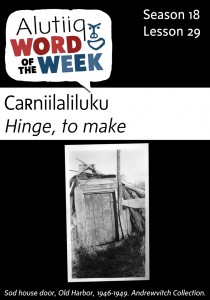 CaRniilalirluku – Hinge, to make
CaRniilalirluku – Hinge, to make
ARapamek aturluteng caRniilalitaarlliit. – They used to use rubber boots to make hinges.
Building Alutiiq words is a bit like a math equation. Alutiiq is an agglutinative language, which means that words are formed by adding word parts together. Alutiiq grammar is complex, but it is very standardized. Once you know how to build Alutiiq words, there are very few exceptions to the rules. This is different than English. For almost every grammatical rule in the English language there are exceptions!
Verbs are particularly complicated part of Alutiiq speech. In Alutiiq, verbs include action words like paddle, spear, butcher, cook, eat, and think. However, they also include words like red or ugly, terms considered adjectives in English. Often, you can identify Alutiiq verbs by their endings. In Alutiiq dictionaries and lessons, verbs appear with a luni or luku ending. For example, nerluni means ‘to eat’, and kawirlirluni means ‘to be red.’
Verbs in Alutiiq have stems. Speakers follow a set of rule to identify the verb stem. Then, they add the appropriate suffix to show the time frame, the subject, or the object they wish to describe. These suffixes are known as postbases. Interestingly, postbases allow word roots to become nouns or verbs. The word for hinge, used in this lesson, is a good example. CaRniilaliluku, means hinge, or literally to make hinges.
Hinges likely became important in Alutiiq communities in the historic era, when people began to add western-style doors to their sod houses. Using nails and strips of leather or an old rubber boot, people created strong durable supports for hanging doors.
Source: Alutiiq Museum [xyz-ihs snippet=”Adsense-responsive”]
